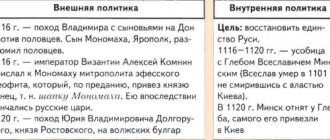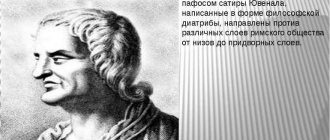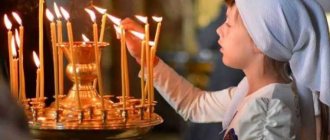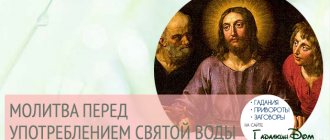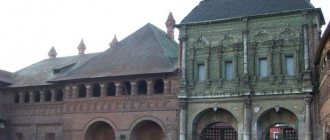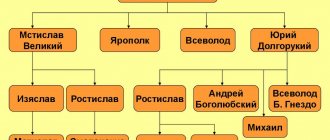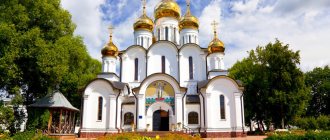We know practically nothing about the life of the Monk Nestor the chronicler before he became a resident of the Kiev-Pechersk Monastery. We do not know who he was by social status, we do not know the exact date of his birth. Scientists agree on an approximate date - the middle of the 11th century. History has not even recorded the secular name of the first historian of the Russian land. And he preserved for us invaluable information about the psychological appearance of the holy brothers-passion-bearers Boris and Gleb, the Monk Theodosius of Pechersk, remaining in the shadow of the heroes of his works. The circumstances of the life of this outstanding figure of Russian culture have to be reconstructed bit by bit, and not all the gaps in his biography can be filled. We celebrate the memory of St. Nestor on November 9.
The Monk Nestor came to the famous Kiev-Pechersk Monastery when he was a seventeen-year-old youth.
The holy monastery lived according to the strict Studite Rule, which was introduced into it by the Monk Theodosius, borrowing it from Byzantine books. According to this charter, before taking monastic vows, the candidate had to go through a long preparatory stage. Newcomers first had to wear secular clothes until they had thoroughly studied the rules of monastic life. After this, the candidates were allowed to put on monastic robes and begin testing, that is, to show themselves in work at various obediences. Those who passed these tests successfully received tonsure, but the test did not end there - the last stage of acceptance into the monastery was tonsure into the great schema, which not everyone was awarded. The Monk Nestor went all the way from a simple novice to a schemamonk in just four years, and also received the rank of deacon. In addition to obedience and virtue, his education and outstanding literary talent played a significant role in this.
The Kiev Pechersky Monastery was a unique phenomenon in the spiritual life of Kievan Rus. The number of brethren reached one hundred people, which was rare even for Byzantium itself. The severity of the communal rules found in the Constantinople archives had no analogues. The monastery also flourished materially, although its governors did not care about collecting earthly riches. The powers that be listened to the voice of the monastery; it had a real political and, most importantly, spiritual influence on society.
The young Russian Church at that time was actively mastering the rich material of Byzantine church literature. She was faced with the task of creating original Russian texts in which the national image of Russian holiness would be revealed.
What was the name of the first Russian chronicle?
Everyone should know the answer to this question. The first Russian chronicle was called “The Tale of Bygone Years.” It was written in 1110-1118 in Kyiv. Linguistic scientist Shakhmatov revealed that she had predecessors. However, this is still the first Russian chronicle. It is called confirmed, reliable.
The story describes a chronicle of events that occurred over a certain period of time. It consisted of articles that described each past year.
Author
The author is considered to be the monk Nestor. It is noteworthy that Nestor, as the author, is mentioned only in later versions of the story, but he is considered by historians to be the first chronicler. He worked in the Kiev-Pechersk Monastery.
The monk described events from biblical times to 1117. The title of the first Russian chronicle is the first lines of the chronicle.
"WINDOWS TO A VISANDED WORLD"
In the XII-XIII centuries. Illustrated manuscripts appear, where events are depicted in drawings, so-called miniatures. The closer the event depicted is to the time of the artist’s own life, the more accurate the everyday details and portrait resemblance. The artists were literate, educated people, and sometimes a miniature drawing tells a more complete story about an event than a text.
The most interesting illustrated chronicle is the so-called Radziwill Chronicle, taken by Peter I from the city of Konigsberg (modern Kaliningrad). It was copied in the 15th century. from an earlier, also illustrated original of the 12th or early 13th century. There are over 600 drawings for it. Researchers call them “windows to a vanished world.”
* * *
Medieval chroniclers - monks, townspeople, boyars - could not break out of the circle of ideas common to that time. So, for example, most major events - the invasion of the “filthy” (Tatars), famine, pestilence, uprisings - they explained by God’s will, the desire of the formidable god to “test” or punish the human race. Many chroniclers were superstitious and interpreted unusual celestial phenomena (eclipses of the sun, comets) as “signs” foreshadowing good or evil.
One of the miniatures of the Radziwill Chronicle. Battle during Prince Igor's campaign against Constantinople in 944.
Typically, chroniclers had little interest in the lives of the common people, since they believed that “historians and poets should describe wars between monarchs and glorify those who died courageously for their master.”
But still, the majority of Russian chroniclers opposed feudal fragmentation, against endless princely feuds and strife. The chronicles are full of patriotic calls for a joint struggle against the greedy hordes of the steppes.
The brilliant author of “The Lay of Igor’s Campaign” (late 12th century), making extensive use of chronicles, used historical examples to show the disastrous danger of princely strife and strife and fervently called on all Russian people to stand up “for the Russian Land.”
For us, ancient chronicles telling about the destinies of our Motherland over almost a millennium will always be the most precious treasure of the history of Russian culture.
If you find an error, please select a piece of text and press Ctrl+Enter.
Kievan Rus and Byzantium
"Mr. Veliky Novgorod"
.
History of creation
The chronicle had copies made after Nestor, which were able to survive to this day. They weren't very different from each other. The original itself was lost. According to Shchakhmatov, the chronicle was rewritten just a few years after its appearance. Big changes were made to it.
In the 14th century, the monk Lawrence rewrote the work of Nestor, and it is this copy that is considered the most ancient that has survived to our time.
There are several versions of where Nestor got the information for his chronicle. Since the chronology goes back to ancient times, and articles with dates appeared only after 852, many historians believe that the monk described the old period thanks to the legends of people and written sources in the monastery.
She corresponded often. Even Nestor himself rewrote the chronicle, making some changes.
The interesting thing is that in those days the scripture was also a code of laws.
V. Creative task
U. On the board you see images of old books. Notice how carefully the letters were written out by the scribe, how the initial letters - the capital letters of the beginning of the text - were decorated with various ornaments. It is not for nothing that the expression “red line” has been preserved from those times - it was precisely red, that is, beautiful. Now try to draw a beautiful antique letter yourself. On the board you see the ancient alphabet, some letters are similar to modern ones, and some are different. What letters are similar to modern ones?
Choose any letter and start drawing.
Yulia Klyueva
Contents of the chronicle
The Tale of Bygone Years described everything: from exact events to biblical legends.
The purpose of the creation was to write a chronicle, record events, restore chronology in order to understand where the Russian people come from and how Rus' was formed.
Nestor wrote that the Slavs appeared a long time ago from the son of Noah. Noah had three in total. They divided three territories among themselves. One of them, Japheth, received the northwestern part.
Then there are articles about the princes, the East Slavic tribes that descended from the Noriks. It is here that Rurik and his brothers are mentioned. It is said about Rurik that he became the ruler of Rus' by founding Novgorod. This explains why there are so many supporters of the Norman theory of the origin of princes from the Rurikovichs, although there is no factual evidence.
It tells about Yaroslav the Wise and many other people and their reign, about wars and other significant events that shaped the history of Rus' and made it what we know it now.
IN THE LIBRARY OF A 12TH CENTURY RECORDER
If you and I found ourselves in ancient Kyiv, for example, in 1200 and wanted to find one of the most important chroniclers of that time, we would have to go to the suburban Vydubitsky monastery to the abbot (chief) Moses, an educated and well-read man.
The monastery is located on the steep bank of the Dnieper. On September 24, 1200, the completion of work to strengthen the bank was solemnly celebrated here. Hegumen Moses delivered a beautiful speech to the Grand Duke of Kyiv Rurik Rostislavich, his family and boyars, in which he glorified the prince and architect Peter Milonega.
Having recorded his speech, Moses completed his great historical work with it - a chronicle that covered four centuries of Russian history and was based on many books.
In ancient Rus' there were many monastic and princely libraries. Our ancestors loved and appreciated books. Unfortunately, these libraries were destroyed by fire during Polovtsian and Tatar raids.
Only through a painstaking study of surviving handwritten books did scientists establish that in the hands of the chroniclers there were many historical and church books in Russian, Bulgarian, Greek and other languages. From them, chroniclers borrowed information on world history, the history of Rome and Byzantium, descriptions of the life of various peoples - from Britain to distant China.
Abbot Moses also had at his disposal Russian chronicles compiled by his predecessors in the 11th and 12th centuries.
Moses was a true historian. He often used several chronicles to cover an event. Describing, for example, the war between the Moscow prince Yuri Dolgoruky and the Kyiv prince Izyaslav Mstislavich, he took notes made in hostile camps, and found himself, as it were, above the warring parties, above the feudal borders. One of the princes was defeated in a bloody battle and fled “no one knows where.” But “unknown” to the victors and to the chronicler of the victorious side, Moses picked up another chronicle, written for the defeated prince, and wrote down from there into his consolidated chronicle everything that this prince did after the defeat. The value of such a chronicle is this. that his readers learn everything from different chronicles, united in one historical work.
The chronicle corpus paints a broad picture of feudal civil strife in the mid-12th century. We can also imagine the appearance of the chroniclers themselves, from whose records the code was compiled. He will be very far from the ideal image of the chronicler Pimen from Pushkin’s drama “Boris Godunov”, who
Calmly looks at the right and the guilty,
Knowing neither pity nor anger,
Listening indifferently to good and evil...
Real chroniclers served the princes with their pens, like warriors with weapons; they tried to whitewash their prince in everything, present him as always right, and confirm this with collected documents. At the same time, they did not hesitate in their means to show the enemies of their prince as oathbreakers, insidious deceivers, inept, cowardly commanders. Therefore, in the code there are sometimes conflicting assessments of the same people.
Reading the description of the princely feuds of the mid-12th century in the vault of Moses, we hear the voices of four chroniclers. One of them was obviously a humble monk and looked at life from the window of the monastery cell. His favorite heroes are the sons of the Kyiv prince Vladimir Monomakh. Continuing the old tradition, this chronicler explained all human affairs as “divine providence”; he did not know life and the political situation properly. Such chroniclers were exceptions.
Excerpts from the book of the court chronicler of the Seversk prince Svyatoslav Olgovich (d. 1164) sound differently. The chronicler accompanied his prince on his numerous campaigns, sharing with him both short-term success and the hardships of exile. He probably belonged to the clergy, since he constantly introduced various church moral teachings into the text and designated every day as a church holiday or the memory of a “saint.” However, this did not prevent him from working on the princely household and on the pages of historical work writing about the exact number of haystacks and horses in the princely villages, about the stocks of wine and honey in the palace storerooms.
The third chronicler was a courtier of the Kyiv prince Izyaslav Mstislavich (d. 1154). He is a good expert in strategy and military affairs, a diplomat, a participant in secret meetings of princes and kings, a writer with a good command of the pen. He made extensive use of the princely archive and included in his chronicle copies of diplomatic letters, recordings of meetings of the Boyar Duma, diaries of campaigns and skillfully compiled characteristics of his contemporaries. Scientists suggest that this chronicler-secretary of the prince was the Kiev boyar Peter Borislavich, whom the chronicle mentions.
Finally, the chronicle contains excerpts from the chronicle compiled at the court of Moscow Prince Yuri Dolgoruky.
Now you know how history was written in the 12th-13th centuries, how a consolidated chronicle was compiled from many sources that reflected the conflicting interests of warring princes.
Meaning
"The Tale of Bygone Years" is of great importance today. This is one of the main historical sources on which historians conduct research. Thanks to her, the chronology of that period has been restored.
Since the chronicle has an open genre, ranging from stories of epics to descriptions of wars and weather, one can understand a lot about the mentality and ordinary life of the Russians who lived at that time.
Christianity played a special role in the chronicle. All events are described through the prism of religion. Even the deliverance from idols and the adoption of Christianity are described as a period when people got rid of temptations and ignorance. And the new religion is light for Rus'.

